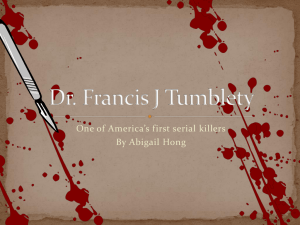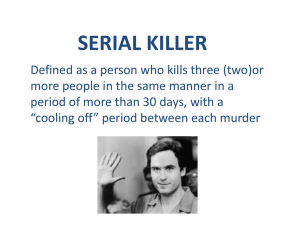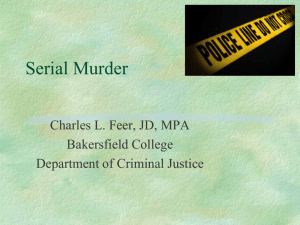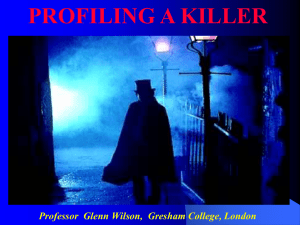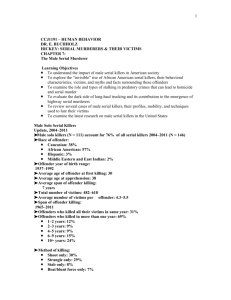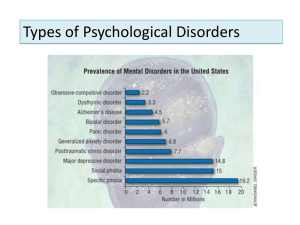Ch. 8 - MDC Faculty Home Pages
advertisement
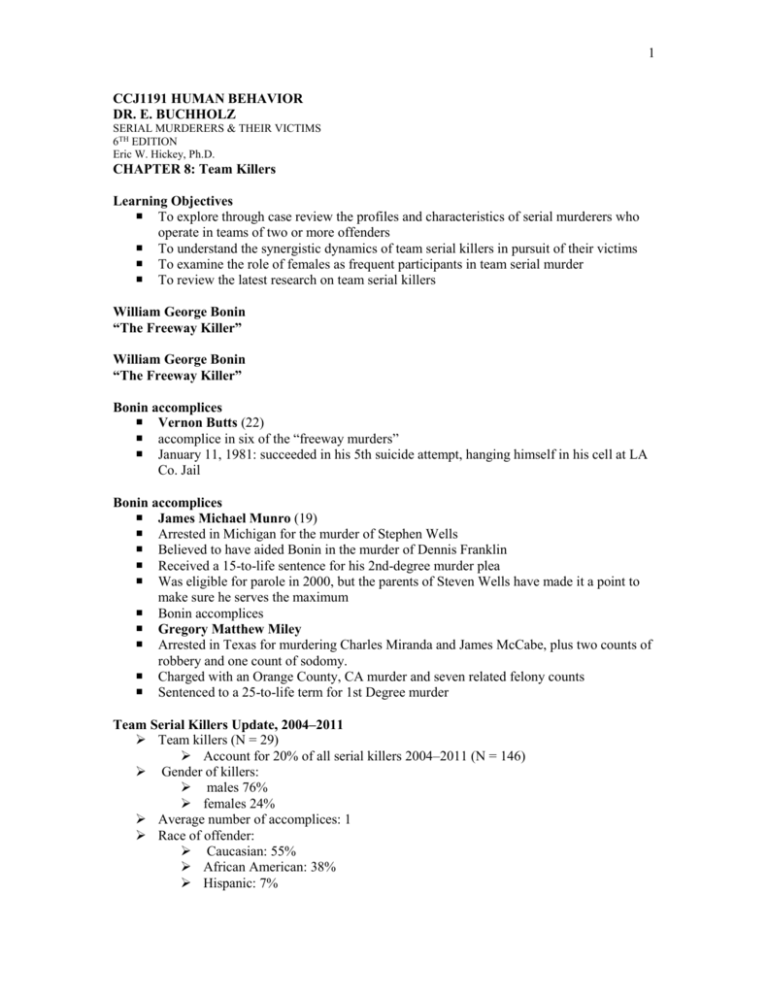
1 CCJ1191 HUMAN BEHAVIOR DR. E. BUCHHOLZ SERIAL MURDERERS & THEIR VICTIMS 6TH EDITION Eric W. Hickey, Ph.D. CHAPTER 8: Team Killers Learning Objectives To explore through case review the profiles and characteristics of serial murderers who operate in teams of two or more offenders To understand the synergistic dynamics of team serial killers in pursuit of their victims To examine the role of females as frequent participants in team serial murder To review the latest research on team serial killers William George Bonin “The Freeway Killer” William George Bonin “The Freeway Killer” Bonin accomplices Vernon Butts (22) accomplice in six of the “freeway murders” January 11, 1981: succeeded in his 5th suicide attempt, hanging himself in his cell at LA Co. Jail Bonin accomplices James Michael Munro (19) Arrested in Michigan for the murder of Stephen Wells Believed to have aided Bonin in the murder of Dennis Franklin Received a 15-to-life sentence for his 2nd-degree murder plea Was eligible for parole in 2000, but the parents of Steven Wells have made it a point to make sure he serves the maximum Bonin accomplices Gregory Matthew Miley Arrested in Texas for murdering Charles Miranda and James McCabe, plus two counts of robbery and one count of sodomy. Charged with an Orange County, CA murder and seven related felony counts Sentenced to a 25-to-life term for 1st Degree murder Team Serial Killers Update, 2004–2011 Team killers (N = 29) Account for 20% of all serial killers 2004–2011 (N = 146) Gender of killers: males 76% females 24% Average number of accomplices: 1 Race of offender: Caucasian: 55% African American: 38% Hispanic: 7% 2 Offender year of birth range: 1931–1991 Average age of offender at first killing: 30.6 Average age at apprehension: 33.4 Average span of offender killing: 3.1 years Total number of victims: 73–91 Average number of victims per offender: 2.5–3.1 Span of offender killing: 1994–2010 Offenders who killed all their victims in same year: 41% Contd. Offenders who killed in more than one year: 59% 1–2 years: 14% 2–3 years: 17% 4–5 years: 7% 6–9 years: 7% 10+ years: 14% Method of killing: Shoot only: 40% Strangle only: 13% Beat/blunt force only: 13% Combination of strangling, beating, stabbing, and/or shooting: 34% Victims of team killers: Adults only: 100% Offenders who targeted specific type of victim: 100% Average number of victims per offender: 4.6–5.7 Strangers only: 100% Prostitutes: 7% Males only: 33% Females only: 13% Male and female victims: 53% Involving more than one state: 20% Team Killers The majority of cases involve only two offenders, whereas the remaining few cases have three or more offenders in each group. The largest group in this study was identified as having five offenders. ( See the Kenneth Bianchi and Angelo Buono profile, p. 264) Team offenders form dyads, triads, and even larger groupings sometimes they are both legally and blood related sometimes they are strangers and acquaintances A cooperative relationship… The lust for power is the chameleon of vices and as such can be perceived and experienced in many different ways. For some multiple killers, murder must be simultaneously a participation and a spectator endeavor; power can be experienced by observing a fellow conspirator destroy human life, possibly as much as by performing the killing. 3 The pathology of the relationship operates symbiotically. In other words, the offenders contribute to each other’s personal inventory of power. What they could never become alone, they can aspire to collectively. Relationships In the nonrelative category, males almost exclusively assumed leadership. Cases were extremely rare in which nonrelated females masterminded multiple homicides, but they do occur. ( See the Olga Rutterschmidt and Helen Golay profile, p. 267) Black Widow Killers Olga Rutterschmidt and Helen Golay Appeared to be kindly old women spending their last days helping the less fortunate. They stopped by the Sunday lunch for the homeless at Hollywood Presbyterian Church. Olga lived in a well-worn Sycamore Avenue apartment building. Helen owned rental properties on the westside and lived in one of her own buildings on Ocean Park Boulevard. Olga and Helen preyed on homeless men, befriending them, and obtaining insurance policies for them. Afterwards, they'd kill the men, making it appear like hit and run accidents. They were arrested by the LAPD on May 18, 2006. On April 16, 2008, they were convicted and sentenced to life in prison without the possibility of parole. Aged 75 and 77, respectively, at the time of their trial in 2008. They murdered two homeless men — Kenneth McDavid, aged 50, in 2005 and Paul Vados, aged 73, in 1999 — staging their deaths to appear as hit and run incidents. They then collected life insurance policies that they had taken out on the two men, for a total of $2.8 million. Without exception, every group of offenders had one person who psychologically maintained control of the other members of the team. Some of these leaders were Charles Manson types who exerted an almost mystical control over their followers; others used forms of coercion, intimidation, and persuasive techniques. Male and Female Teams In other rare cases women have dominated the male in the killing relationship. (See the Martha Beck and Ray Fernandez profile, p. 268) Some of those who led groups of team offenders experienced a sense of power and gratification not only through the deaths of victims but also through getting others to do their bidding. The “Lonely Hearts Killers” On March 8, 1951, the made-for-tabloids killer couple Raymond Fernandez and Martha Beck were electrocuted at New York’s Sing Sing prison for murder. Contd. The females described in this chapter who are part of the subgroup of male-female team killers, tend to be, with a few exceptions, followers, not leaders. However, some of these followers quickly learned how to kill, became “equal partners in the killing,” and participated directly in some of the bloodiest murder cases ever chronicled. 4 (See the Alton Coleman and Debra D. Brown profile, p. 269) Alton Coleman and Debra Brown Contd. Leaders of some groups tend to go through a process of self-abdication and place culpability for the murders on the followers. In one case the group leader, denying absolutely any involvement in a series of horrific mutilation murders, contended that his ex-girlfriend had conceived and executed the murder plans. (See the Douglas D. Clark and Carol A. Bundy profile, p. 272) Doug Clark and Carol Bundy Doug Clark and Carol Bundy were responsible for "the Sunset Strip Slayings" in Hollywood in the early 1980s. Bundy would entice women into the car so that Clark could force them into sexual acts, during which he would shoot them in the head. He would then have sex with the corpses...or just with a severed head. Contd. For some followers, killing first became acceptable and then desirable. Others continued to kill solely as a result of their relationship with whoever held the reins of leadership. (See the Gerald A. Gallego Jr. and Charlene Gallego profile, p. 284) When the couple had been together for a year, he said that he needed a pair of love slaves to turn him on and asked Charlene to procure them. The Gallegos targeted women. Their first victims were in their teens, but the later ones were in their early 20s. More often than not, they abducted two at a time. They would abduct them from public or semi-public places, often at gunpoint with a .357 Magnum, with Charlene acting as the lure, and take them into their van, where Gerald would rape them repeatedly before killing them in various ways, usually by shooting them with a .25 Beretta or bludgeoning them with some incidental object. Linda Aguilar and Virginia Mochel, both of whom were abducted alone, were strangled. Convicted killer Gerald Gallego listens to his death sentence in Contra Costa County Superior Court. He was sentenced to die in the gas chamber for the murder of a college couple in 1980. (May 25, 1983) Gallego’s Original Pen Pal Request My name is Gerald Gallego. I am 54 years old and I will soon be starting my 21st year on Death Row. I was arrested Nov 17, 1980, in Omaha, Neb. I was returned to California. In 1983, I was convicted of murder and sentenced to Death. I was then extradited to the State of Nevada. On June 24, 1984, I was convicted of murder in the State of Nevada and sentenced to death. I have been fighting the convictions and death sentences in both states through out all these years. My family is all dead and gone. All my friends somehow vanished after my arrest. Over these 20 years, I have had very little to do with the outside world. My appeals is starting to come to an end (both states) and I am looking for a friend. I am looking for a person that is honest in words and sincere at heart. Someone that will stand with me and befriend me until the end. I'm not looking for a lot of friends - just one true one. As you can see by my poor writing, my misspelling, etc, I am not a well educated man. I don't know if I have anything to offer anyone. I don't have anything to offer anyone except my friendship. I guess what I'm trying to say is I just don't want to go down the road by myself anymore...I don't have any picture of myself...maybe you know 5 someone that might want to write me. I am not very good at letter writing, and somedays are harder than others. But I will try and be a very good penpal to someone. Sincerely yours, Died of cancer in prison - July 18, 2002, age 56 Northern Nevada Correctional Center Charlene was released in 1997, age 41 Unusual Groups There are other types of male-female team serial killers that do not fit traditional concepts of serial murder, yet they are serial killers by definition. (See the Tene Bimbo Gypsy Clan profile, p. 268) With only a few exceptions, most of these team offenders did not receive college education, and only a few received postsecondary education, such as vocational training. In brief, they were generally ill prepared to achieve occupationally successful careers. Mobility Having more than one offender involved in serial killing id not increase the number of victims per case. Solo offenders were a little more likely, on average, to kill more victims When two or more offenders are involved in a case, the chances of someone talking or leaving evidence at or near the crime scene increase. Victimization Team killers do not appear to be gender-specific, and equally select both males and females as targets, especially those who are adults. About half of all team cases and offenders killed both males and females. Strangers were the most common type of victim, and there was a preference for adults over children. (See the Henry Lee Lucas and Ottis Elwood Toole profile, p. 274) Contd. Offender mobility data indicates that team killers are most likely to remain in local proximity to their killing sites and least likely to be classified as place-specific offenders. The majority of cases involve stranger-to-stranger violence. Risk-takers such as prostitutes and hitchhikers were at greater risk than those who avoided such lifestyles. Methods Guns were commonly used by team offenders during the commission of their crimes (see Table 8.8). However, guns only were used in approximately one out of four cases as the sole method of killing. As in other serial murders, the purpose was usually not to dispose of victims quickly but to keep them alive so they could be subjected to tortures and mutilations. (See the Dean A. Corll, David O. Brooks, and Elmer Wayne Henley profile, p. 280) Murder Ventures Some team killers group themselves together in almost businesslike ventures that culminate in murder. 6 (See the Leonard Lake and Charles Ng profile, p. 282) Lake had settled on two and a half acres of woodland near Wilseyville, in Calaveras County, enlisting the help of neighbors to construct a fortified bunker beside his cabin, stockpiling illegal weapons and stolen video equipment. Team killers were twice as likely to come from unstable homes as solo killers Solo offenders were much more prone to report feelings of rejection than team serial offenders. Disposition The problem is we are not keeping these offenders incarcerated and are freeing convicted psychopathic felons every year who go on to become some of America’s most infamous serial murders. End of Chapter 8 Related Movies Henry, Portrait of a Serial Killer – (Based on the true story of Henry Lucas and Otis Toole). The Hillside Stranglers – (Based on the true story of Ken Bianchi and Angelo Buono). Helter Skelter – (Based on the true story of Charles Manson and his “family”). Related Websites: 1. TruTV: William Bonin: The Freeway Killer, www.trutv.com/library/crime/serial_killers/predators/bonin/killer_4.html. Deseret News: Serial Killer Myron Lance Dies after Years in Prison, www.deseretnews.com/article/700061597/Serial-killer-Myron-Lance-dies-after-years-inprison.html. The Guardian: In Cold Blood, Half a Century On, www.guardian.co.uk/books/2009/nov/16/truman-capote-in-cold-blood.
